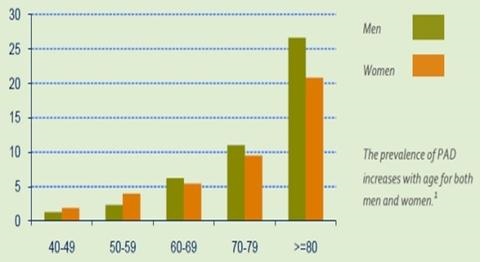What is Peripheral Arterial disease (poor leg circulation)?
Peripheral arterial disease (PAD) in the legs means the narrowing of blood vessel of the legs caused by build of the fatty plaque in the arteries like plaque build in the heart arteries in heart disease. It involves more commonly leg arteries, but it can involve arteries of the arms also.

Prevalence of PAD (%) by Age Group (Years): heart disease and stroke statistics updates 2020
What are the risk factors for PAD?
- Smoking
- High blood pressure
- Atherosclerosis (clogging up of arteries with fatty plaque)
- Diabetes Mellitus
- High blood cholesterol
- Age above 60 years
Importantly both men and women are affected by PAD. It is more common in African American and Hispanics and patients with above mentioned risk factors.
Who should get Ankle Brachial Index (ABI) screening for Peripheral Arterial disease?
Screening of PAD is done using simple bedside test called Ankle Brachial Index as shown in the top image. It is a simple painless test like measuring routine blood pressure. But in this test as name suggest, blood pressure is measured using regular blood pressure cuff in the arm as well as the ankle region using the handheld doppler or stethoscope. Ankle brachial index is calculated to give you the number which will guide us in the management. Guidelines for PAD screening is not clear. Our team will perform this test as shown in the picture at bedside where indicated clinically or for follow up of the patients who has prior diagnosis of peripheral arterial disease to monitor the progression of the narrowing.
What are the signs and symptoms of Peripheral artery disease?

The most common symptoms are pain in the legs during physical activity such as walking. You might feel leg pain or cramps in the calf region on walking that might get better after rest. Importantly, 4 out of 10 patients with peripheral artery disease have no leg pain. Pain can happen in the buttock, hip, or thigh region as well on physical activity.
Following are the physical signs that might indicate peripheral artery disease:
- Muscle weakness (atrophy-losing muscle mass)
- Loss of hair on the affected limb
- Skin on the affected limb becomes smooth, shiny, and cold to touch
- Reduced or absent pulses in the feet, cold or numb toes
- Non-healing ulcers or sores in the legs especially
How is it screened and diagnosed?
Out team will screen you for PAD when clincally indicated. We might send you to get further testing to get the details of the arteries of the legs or arms such as ultrasound called Arterial Doppler, Magnetic Resonance Angiography and Computed Tomographic Angiography (requiring contrast dye).
What are the complications of untreated or uncontrolled Peripheral Arterial disease?
Common complications in untreated or uncontrolled PAD includes:
- Non healing ulcers or wound in the leg
- Gangrene (dying of body part parts due to lack of blood supply) of the fingers and toes
- Serious cases end up requiring amputations of the fingers, toes, or part of the limbs.
How is Peripheral Artery disease managed-prevented and treated?
Important step for prevention is physical activity, modified diet, smoking cessation, keeping your diabetes and blood pressure under control, and taking blood thinners commonly prescribed by treating physician. An appropriate patient will be sent either to cardiologist or vascular surgeon for advance care. Our team will be with you throughout the complete testing and treatment phase. We will also teach the patients how to check for early warning signs and symptoms at home.

